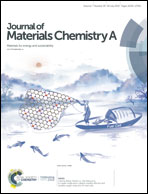Delignified wood with unprecedented anti-oil properties for the highly efficient separation of crude oil/water mixtures†
Abstract
It remains a challenge to develop anti-oil fouling materials for crude oil spills or other oily wastewater cleanups. Herein, we report delignified wood with a cellulose coating for its excellent oil-repellent properties and efficient crude oil/water separation abilities. The delignified wood shows stable water binding affinity and an ultralow underwater adhesion force. It is not only useful for totally separating or collecting crude oil from oily wastewater with no decline in water permeation flux during long-term operation, but also shows good pH stability and high salt resistance. The excellent anti-oil properties originated from the chemical structure of cellulose, in which the hydrophilic hydroxyl groups are densely and symmetrically linked to the main chains. It is capable of being further improved with a cellulose coating fabricated from the hydrolysis of cellulose acetate. The cellulose coating allows the delignified wood to remove oil contamination from its surfaces both in a pre-hydration state and in a dry state while the nascent state only works well underwater because of remaining impurities, like lignin and hemicellulose. Our results demonstrate that the delignified wood and cellulose coating show great potential in the practical treatment of oily wastewater.



 Please wait while we load your content...
Please wait while we load your content...